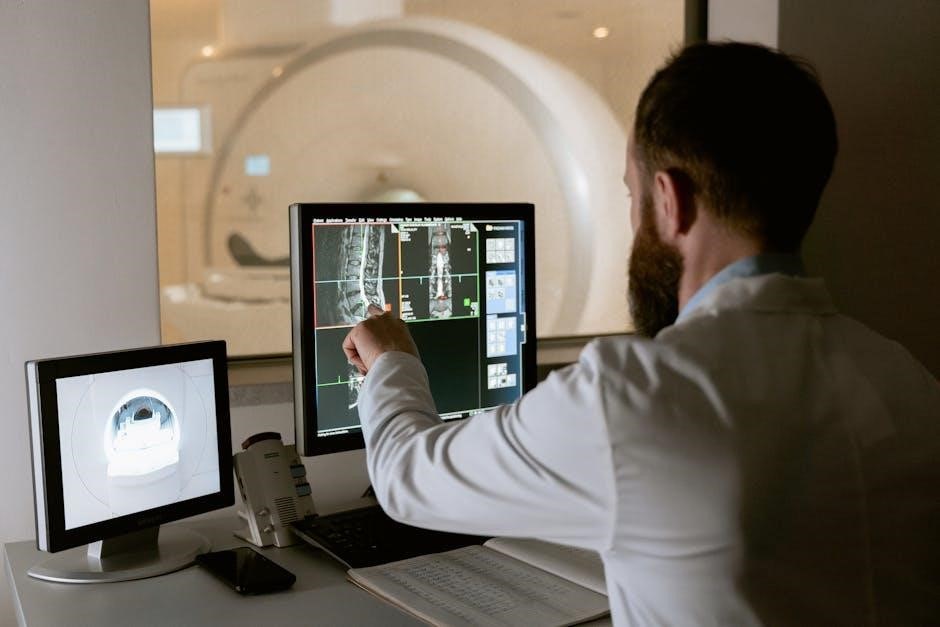
The Myers-Briggs Type Indicator (MBTI) is a widely used self-assessment tool, helping individuals understand their personality preferences across four dimensions. Rooted in Carl Jung’s theory, it categorizes people into 16 unique types, offering insights into behavior, communication, and decision-making. The MBTI PDF guide provides a structured framework for self-discovery and personal growth, making it a valuable resource for both personal and professional development.
1.1 Overview of the MBTI Assessment
The Myers-Briggs Type Indicator (MBTI) assessment is a psychological tool designed to identify individual preferences across four dichotomies: introversion vs. extraversion, sensing vs. intuition, thinking vs. feeling, and judging vs. perceiving. It categorizes individuals into 16 distinct personality types, providing insights into behavior, decision-making, and communication styles. The assessment is widely used in personal development, career guidance, and team building to enhance self-awareness and interpersonal understanding.
1.2 Historical Background and Development
The MBTI was developed by Isabel Briggs Myers and her mother, Katherine Cook Briggs, during World War II. Inspired by Carl Jung’s theory of psychological types, they aimed to help women enter the workforce by identifying suitable roles. The test evolved over decades, with the final version published in 1996. It remains a popular tool for understanding personality preferences and fostering personal and professional growth.
1.3 Importance of Personality Assessments in Modern Psychology
Personality assessments like the MBTI play a crucial role in modern psychology by providing insights into individual preferences and behaviors. They aid in personal growth, career guidance, and team dynamics. The MBTI PDF guide is particularly valued for its accessibility, offering a structured framework for self-reflection and development. It remains a widely used tool in education, employment, and personal development, promoting self-awareness and effective communication.
The Myers-Briggs Personality Test PDF Guide
The Myers-Briggs Test PDF guide is a comprehensive resource for understanding personality types. It offers insights into MBTI frameworks, practical applications, and tools for personal growth and career development.
2.1 Structure and Content of the MBTI PDF
The MBTI PDF guide typically includes an introduction to the assessment, detailed explanations of the 16 personality types, and practical applications for self-awareness. It often features sections on understanding preferences, interpreting results, and applying insights to personal and professional life. The content is structured to help users navigate the framework effectively, making it a valuable tool for both individuals and professionals.
2.2 How to Access and Use the Myers-Briggs Test PDF
To access the Myers-Briggs Test PDF, visit authorized distributors like the Myers-Briggs Foundation or CPP. Download the guide, which includes the assessment questionnaire. Complete the test by selecting preferences, then score it using the provided instructions. Review the results to identify your personality type and explore insights for personal growth and decision-making.
2.3 Benefits of Using the MBTI PDF for Self-Assessment
The MBTI PDF offers a clear framework for self-discovery, enabling individuals to gain insights into their personality preferences. It provides practical tools for personal growth, helping users identify strengths and areas for improvement. The guide also offers actionable advice for career development and interpersonal relationships, making it a versatile resource for self-assessment and lifelong learning.

Understanding the 16 Personality Types
The MBTI identifies 16 distinct personality types, each offering unique insights into individual preferences and behaviors, helping individuals and teams enhance self-awareness and interpersonal effectiveness.
3.1 The Four Dichotomies: Introversion vs. Extraversion, Sensing vs. Intuition, Thinking vs. Feeling, Judging vs. Perceiving
The MBTI is built on four dichotomies, each representing opposing preferences. Introversion (I) vs; Extraversion (E) reflects energy sources, Sensing (S) vs; Intuition (N) relates to information processing, Thinking (T) vs. Feeling (F) concerns decision-making, and Judging (J) vs. Perceiving (P) describes lifestyle. These dichotomies form the foundation for understanding personality differences and shaping the 16 unique types.
3.2 Detailed Overview of Each Personality Type
The Myers-Briggs test categorizes individuals into 16 distinct personality types, each defined by unique combinations of the four dichotomies. These types include ISTJ, ISFJ, INFJ, INTJ, ISTP, ISFP, INFP, INTP, ESTP, ESFP, ENFP, ENTP, ESTJ, ESFJ, ENFJ, and ENTJ. Each type highlights specific traits, strengths, and weaknesses, providing insights into behavioral patterns, decision-making styles, and interpersonal interactions.
3.3 How to Determine Your Personality Type Accurately
To determine your personality type accurately, start with self-reflection on your natural tendencies. Take the official MBTI assessment or a reliable alternative. Review the four dichotomies carefully, considering how you behave in different situations. Consult resources or a certified practitioner to clarify uncertainties. Continuous learning and self-awareness will refine your understanding and help pinpoint your type effectively.

How the MBTI Test Works
The MBTI test evaluates preferences across four dichotomies, using forced-choice questions to determine personality type, resulting in a four-letter code defining individual preferences and behaviors.
4.1 The Science Behind the Myers-Briggs Assessment
The MBTI is rooted in Carl Jung’s theory of psychological types, categorizing individuals into 16 personality types based on four dichotomies. The assessment uses a forced-choice format to identify preferences for introversion or extraversion, sensing or intuition, thinking or feeling, and judging or perceiving. While its scientific validity is debated, the MBTI remains widely used for self-awareness and personal development due to its practical applications.
4.2 The Role of Carl Jung’s Theory in the MBTI
Carl Jung’s theory of psychological types forms the foundation of the MBTI. His concepts of introversion and extraversion, sensing and intuition, thinking and feeling, and judging and perceiving were expanded by Myers and Briggs. Jung’s ideas about dominant and auxiliary cognitive functions also influenced the test’s structure, aiming to help individuals understand their preferences and behavioral tendencies for personal growth and self-awareness.
4.3 Validity and Reliability of the MBTI as a Psychological Tool
The MBTI’s validity and reliability have been debated in psychological circles. While it is widely used, some critics argue its lack of empirical support and test-retest reliability issues. However, many find value in its practical applications for self-awareness and team dynamics, despite the ongoing debate over its scientific rigor and ability to consistently measure personality traits across different administrations.

Applications of the Myers-Briggs Test
The MBTI is widely used for team-building, career guidance, and personal development, helping individuals and organizations understand strengths and improve communication in diverse settings.
5.1 Use in Personal Development and Growth
The MBTI helps individuals identify strengths, weaknesses, and growth opportunities, fostering self-awareness and personal development. It guides goal-setting, improves decision-making, and enhances communication skills, empowering individuals to align their actions with their core values and aspirations, leading to a more fulfilling and purpose-driven life.
5.2 Role of MBTI in Career Guidance and Employment
The MBTI is widely used in career guidance to help individuals identify roles that align with their personality traits, enhancing job satisfaction and workplace fit. It aids in career exploration, employment decisions, and professional development by highlighting strengths and preferences, ensuring individuals can thrive in environments that match their natural tendencies and values.
5.3 Applications in Team Building and Leadership Development
The MBTI is instrumental in team building by identifying complementary strengths and weaknesses, fostering collaboration and communication. In leadership development, it helps individuals understand their leadership style, enabling them to adapt strategies that align with their personality type. This promotes effective team dynamics and enhances leadership potential, creating cohesive and productive work environments.
5.4 Use in Educational Institutions for Student Assessment
The Myers-Briggs Test PDF is widely used in educational settings to help students identify their strengths and preferences. It aids in personalized learning strategies, career counseling, and improving teacher-student dynamics. By understanding personality types, educators can create tailored lesson plans and foster a more inclusive and supportive learning environment, enhancing student engagement and academic success.

How to Take the Myers-Briggs Test
Taking the Myers-Briggs Test involves answering a series of multiple-choice questions. It’s straightforward, requiring honest responses to determine preferences. The test provides insights into personality traits.
6.1 Step-by-Step Guide to Completing the MBTI Assessment
Start by accessing the MBTI test through an approved platform or printable PDF. Set aside 30-45 minutes for uninterrupted completion. Read instructions carefully and answer questions honestly, selecting options that best reflect your natural preferences. Review responses before submission to ensure accuracy. Upon completion, submit the test for scoring. Results will provide insights into your personality type. Follow the guide for interpretation.
6.2 Understanding the Questionnaire and Response Options
The MBTI questionnaire consists of multiple-choice questions designed to identify preferences across four dichotomies. Each question offers two or more response options, prompting users to choose their natural tendencies. The forced-choice format ensures clarity in distinguishing preferences. Questions are neutral and non-invasive, focusing on behaviors and decision-making styles. Respondents are encouraged to select answers that reflect their typical habits, not idealized versions of themselves.
6.3 Tips for Getting Accurate Results from the Test
To ensure accurate MBTI results, answer questions honestly, reflecting your natural tendencies rather than idealized behaviors. Minimize distractions and take your time to avoid rushed decisions. Consider your long-term preferences rather than temporary feelings. Review ambiguous questions to ensure clarity. Consistency in responses is key, as the MBTI assesses preferences, not skill levels or emotional states. Self-awareness enhances reliability.

Interpreting Your MBTI Results
Understanding your MBTI results involves recognizing your unique preferences and how they influence behavior, decision-making, and interactions. Self-awareness is key to leveraging insights effectively.
7.1 Understanding Your Four-Letter Personality Code
Your MBTI results are summarized in a four-letter code, representing preferences across four dichotomies: Introversion (I) vs. Extraversion (E), Sensing (S) vs. Intuition (N), Thinking (T) vs. Feeling (F), and Judging (J) vs. Perceiving (P). Each letter reflects your tendencies, shaping how you interact with the world. This code provides a framework for self-awareness and personal growth, helping you understand your strengths and approach to decision-making. Accurate interpretation is key to leveraging its insights effectively in personal and professional contexts.
7.2 How to Analyze Your Strengths and Weaknesses
Analyzing your MBTI results helps identify strengths, such as decision-making or communication skills, and weaknesses, like inflexibility or overthinking. Reflect on how your type operates under stress and growth opportunities. Leverage your strengths while addressing weaknesses through self-awareness and feedback. This process fosters personal and professional growth, enabling you to capitalize on your natural tendencies and improve areas for development.
7.3 Using Your Results for Personal and Professional Growth
Your MBTI results provide insights to enhance personal and professional growth. Use your type to identify career paths, improve communication, and build stronger relationships. Set goals aligned with your strengths and work on weaknesses. Self-awareness helps in decision-making and leadership. Apply these insights to foster growth, ensuring a fulfilling and purpose-driven life both personally and professionally.

The Myers-Briggs Test PDF in Practice
The MBTI PDF offers practical tools for self-assessment, team building, and educational purposes, providing a versatile framework for understanding personality traits in various real-world applications.
8.1 Printable Versions of the MBTI Assessment
Printable MBTI PDF versions are readily available online, offering a convenient way to manually assess personality types. These documents often include the full questionnaire, scoring instructions, and interpretation guidelines. They are ideal for self-administration or group sessions, ensuring ease of use without digital tools. Printable formats maintain the test’s structure and validity, making them a reliable option for both personal and professional settings;
8.2 How to Score and Interpret the Test Manually
Scoring the MBTI manually involves tallying responses for each dichotomy: Introversion (I) vs. Extraversion (E), Sensing (S) vs. Intuition (N), Thinking (T) vs. Feeling (F), and Judging (J) vs. Perceiving (P). Sum the selections for each category and determine the dominant trait. Interpretation requires mapping the four-letter code to personality insights, often using official MBTI guides for accuracy and understanding.
8.3 Using the PDF Guide for Group Assessments
The MBTI PDF guide is invaluable for group assessments, enabling facilitators to structure workshops and activities. Distribute the guide to participants, ensuring each has a copy for reference. Use the content to foster discussions on personality types, encouraging collaboration and understanding. A group setting allows for comparative insights and team-building exercises, enhancing overall engagement and learning. Facilitators can guide interpretations and applications, promoting a shared experience.

Common Misconceptions About the MBTI
The Myers-Briggs test is often misunderstood, with critics questioning its scientific basis. Many mistakenly believe it categorizes individuals into rigid types, ignoring its fluid spectrum approach.
9.1 Debunking Myths About the Myers-Briggs Test
One common myth is that the MBTI lacks scientific validity, though it remains widely used for its practical applications. Another misconception is that it rigidly categorizes individuals, when in fact, it offers a spectrum of preferences. Additionally, some believe the test predicts career success, but its primary purpose is self-awareness and personal growth, not forecasting outcomes. These misunderstandings often stem from misinterpretation of its intent and design.
9.2 Addressing Criticisms of the MBTI’s Scientific Validity
The MBTI has faced criticism for lacking strong empirical support and test-retest reliability. Critics argue its four dichotomies oversimplify personality traits, which exist on a spectrum. While not a scientifically rigorous tool, its practical value lies in fostering self-reflection and communication, making it popular despite its limitations in academic psychology.
9.3 Understanding the Limitations of the Assessment
The Myers-Briggs Personality Test lacks strong empirical support and has low test-retest reliability, with its forced-choice format oversimplifying personality traits. It doesn’t capture the complexity of human behavior, leading to potential misuse in professional settings like hiring or education. Without proper context or expert interpretation, results can be misunderstood, emphasizing the need for cautious application of the assessment.

Advanced Topics in MBTI
Advanced MBTI topics explore cognitive functions, type dynamics, and stress responses, offering deeper insights into personality development and behavior under different conditions for personal and professional growth.
10.1 Exploring the Cognitive Functions in Depth
Cognitive functions are the mental processes that shape personality types, consisting of sensing, intuition, thinking, and feeling, each with an extraverted or introverted orientation. Understanding these functions provides insight into how individuals perceive, process information, and make decisions. Exploring cognitive functions deeply reveals how they influence behavior, interactions, and personal growth, offering a nuanced perspective on personality development and typological differences;
10.2 Understanding the Concept of Type Dynamics
Type Dynamics explains how the 16 Myers-Briggs personality types function internally, focusing on the interplay of cognitive processes. It introduces the concept of dominant, auxiliary, tertiary, and inferior functions, illustrating how individuals develop and use these preferences. This framework helps understand personal growth, as people may evolve by developing less-preferred functions; It’s valuable for team building and career guidance, offering insights into behavioral patterns and interactions, though its scientific basis is sometimes questioned.
10.3 The Role of Stress and Personality Development
Stress significantly impacts personality development by influencing how individuals engage with their cognitive functions. Under pressure, people may revert to their dominant preferences, sometimes leading to overuse or imbalance. Stress can also prompt exploration of less-preferred functions, fostering growth. Understanding this dynamic helps individuals manage stress effectively, promoting personal development and emotional resilience while aligning with MBTI principles.

The Future of the Myers-Briggs Test
The Myers-Briggs Test will likely evolve with technology, incorporating AI for personalized insights and broader applications in personal and professional growth globally.
11.1 Evolving Applications of the MBTI in the Digital Age
The MBTI is adapting to digital advancements, offering online assessments and AI-driven insights. Mobile apps and virtual platforms enhance accessibility, while big data analytics refine personality mapping. AI integration enables personalized feedback and dynamic question adaptation, making the test more engaging and precise for users worldwide.
11.2 Potential Enhancements to the Assessment Tool
Future enhancements could include advanced AI algorithms for more precise type identification and personalized reports. Incorporating real-time feedback and adaptive questioning could improve accuracy. Enhanced data visualization and benchmarking tools would help users compare their results with others. Integrating gamification elements could make the assessment more engaging, while ensuring cultural adaptability expands its global relevance and accessibility.
11.3 The Role of AI in Modern Personality Assessments
AI enhances personality assessments by improving accuracy, speed, and personalization. It analyzes vast datasets to refine type classifications and offers adaptive testing for precise results. AI-driven tools provide real-time feedback and integrate natural language processing for deeper insights. Scalability and accessibility are boosted, enabling widespread use while addressing ethical concerns like data privacy and algorithmic bias to ensure fair and reliable outcomes.
12.1 Summary of the Myers-Briggs Personality Test PDF
The Myers-Briggs Test PDF is a comprehensive guide to understanding personality types. It includes historical context, assessment structure, and practical applications. The guide helps individuals identify their strengths and weaknesses, fostering personal and professional growth. With detailed instructions and insights, it remains a valuable tool for self-assessment and development in various settings. Its accessible format makes it widely used for both individual and group purposes.
12.2 Final Thoughts on the Value of the MBTI Assessment
The MBTI assessment remains a widely recognized tool for fostering self-awareness and personal growth. Its ability to categorize personalities into relatable types makes it accessible for various applications. While it has limitations, its value lies in its simplicity and practicality for team building, career guidance, and personal development. Used responsibly, it continues to empower individuals and organizations, offering insights that enhance understanding and collaboration.
